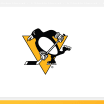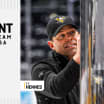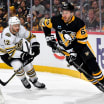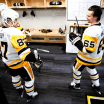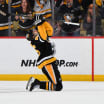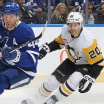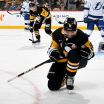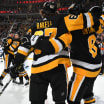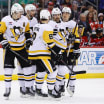This article is an abbreviated excerpt from the book: Pittsburgh Penguins Back-to-Back Champions. This article is part five of a 12-part series complimenting AT&T SportsNet's re-airing of the 2016 and '17 Stanley Cup Final victories by the Penguins.
Click here for AT&T SportsNet's re-air schedule.
Click here to view all 2016 Stanley Cup Final rewind coverage.
B2B Rewind: Final run-up
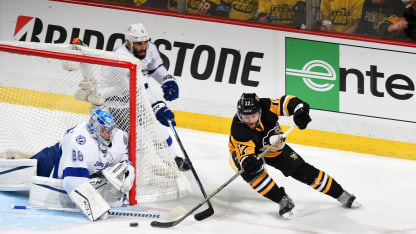
© Joe Sargent
The Eastern Conference Final would take a radical turn in the opening period of Game 1. Tampa Bay goalie Ben Bishop played a puck behind his own goal and as he scrambled to get back into his crease he fell awkwardly to the ice. Bishop writhed in pain on the ice, using his blocker to shield the grimace on his face. A stretcher was brought onto the ice and Bishop was carted off of the ice. The Lightning turned to a 21-year-old goaltender for the remainder of the series, Andrei Vasilevskiy, the club's first-round pick in the 2012 NHL Draft, which took place in the same venue in Pittsburgh, PPG Paints Arena.
The Lightning would strike first late in the first period when Alex Killorn tallied with 1:14 left. They would add two more goals in the second period to take a 3-0 lead. Pittsburgh would tack on a power-play goal from Patric Hornqvist with 55 seconds left in regulation, but it was too little, too late. Pittsburgh fell in Game 1, 3-1.
A wide-open first period highlighted Game 2 with each team scoring twice. That deadlock, 2-2, would hold up over the remaining 40 minutes and the contest entered overtime. The Penguins were desperate for a goal. Pittsburgh did not want to travel to Tampa for Games 3 and 4 having been swept in the first two matchups at home. It was a dire circumstance for the Penguins.
When the Penguins needed Sidney Crosby the most, their captain stepped up to deliver. Defenseman Brian Dumoulin held the puck near the red line and found Bryan Rust streaking toward the Tampa zone. Rust gained the zone and dropped the puck to Crosby between the circles. He wasted little time in snapping off a shot high and near side that whizzed by the blocker of Vasilevskiy. It took only 40 seconds of sudden death overtime for the series to be tied at 1-1.
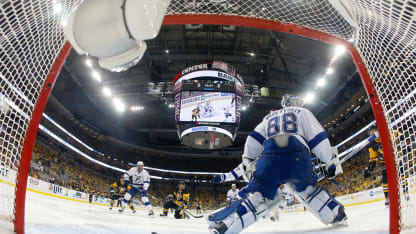
© Greg Shamus
Vasilevskiy was tested early and often in Game 3 by the Penguins. Pittsburgh would put 31 shots on the young netminder through the first two periods of play. Vasilevskiy stopped the first 30 of those shots, but the last one, a rebound shot by Carl Hagelin, gave Pittsburgh a 1-0 with 10 seconds left in the second period.
Pittsburgh would blow the game open in the third period. Goals from Phil Kessel, Crosby and Chris Kunitz gave the Penguins a 4-1 lead. Pittsburgh would outshoot the Lightning, 48-28, en route to a 4-2 win and a 2-1 series advantage.
The Lightning offense exploded in Game 4. The assault began just 27 seconds into the game when Ryan Callahan tipped a shot in the slot past Matt Murray's outstretched glove. Tampa would add three more goals to jet out to a 4-0 lead with 2:12 left in the second period. Murray surrendered all four goals on 30 shots.
To make matters worse, the team lost one of its key contributors on the blue line halfway through the second period. Defenseman Trevor Daley absorbed a hit into the boards by Callahan and fell to the ice. He tried twice to stand up, only to collapse to the ice. Daley crawled to the crease as play continued waiting for the eventual whistle. Daley had suffered a broken ankle. Right away he knew it was bad, but he didn't know then that his season would be done.
As the Penguins left the locker room to start the third period, they were led onto the ice by the longest-tenured Penguin on the roster, Marc-Andre Fleury. It was Fleury's first game action in over seven weeks - 50 days. Before the period-opening faceoff, center Nick Bonino skated up to Fleury and said, "Man, I missed having you back here."
Fleury had been relegated as a spectator for the first 15 playoff games. He suffered a concussion on March 31 during a 5-2 win against Nashville when former teammate James Neal's shot struck him in the mask.
Fleury's spectator duties were over, however, as he skated to the blue paint for the start of the third period in Game 4. Fleury did his part for Pittsburgh, stopping all seven shots he faced, including a breakaway poke-check on Vladislav Namestnikov.
The offense needed to score some goals, and fast. They struck early to give Pittsburgh a pulse as Kessel's laser snap shot from above the circle sailed by Vasilevskiy's blocker to get the Penguins on the board, 4-1.
Malkin and Kunitz would also score to pull the Penguins to within one goal, 4-3, with 6:52 remaining in the game. But the Penguins would run out of clock. The Lightning would survive with a 4-3 win. The series was all even, 2-2, as it headed back to Pittsburgh for Game 5. But the question on everybody's mind was: which goalie would the Penguins start?
Murray had played admirably to that point, going 9-4 with a 2.33 goals-against average and .923 save percentage. He had carried the load throughout the postseason, and many felt he had earned the right to win or lose the series.
Fleury was the goaltender with the pedigree. He was the franchise goaltender for the past decade and had already won a Stanley Cup in 2009. Fleury also had the experience of playing in 99-career playoff games, including high-pressure situations.
Ultimately, head coach Mike Sullivan decided to make a switch. On the morning of Game 5, he declared Fleury would be his starter.
"Lots of things went into the decision," Sullivan said. "I'd rather not elaborate on the details of it, but certainly we had lengthy discussions. We're trying to make the best decision that we think gives our team the best chance to win. That's the route or direction we chose to take for this game."
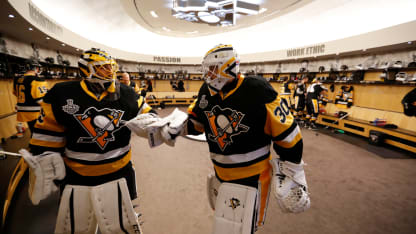
© Greg Shamus
The loudest ovation of the entire postseason in Pittsburgh occurred when Fleury was announced as the game's starter, his 100th career playoff game. He wasn't tested much in the first period, stopping all four shots against, as the Penguins dominated possession. The game remained scoreless as the final seconds were ticking away, but that would all change.
With less than 10 ticks left in the opening frame, Tom Kuhnhackl chipped the puck to Rust, who collected it with speed through the neutral zone. Rust blew around Lightning Redwood tree defenseman Victor Hedman for a semi-breakaway. Although Hedman hounded him during his entire journey to the net, Rust still got off a shot on goal. Vasilevskiy made the save, but kicked the rebound into the slot. Brian Dumoulin trailed on the play, located the puck and buried his shot to record his first career playoff goal with 0.7 seconds left in the period.
The Penguins built a 2-0 lead 90 seconds into the second period on Hornqvist's seventh goal of the season. But the Lightning would net a pair of tallies within 70 seconds of each other to even the score at 2-2.
The Penguins scored another late-period goal to reclaim the lead. Kunitz found a rebound in the slot and slammed it into the net with 49.6 seconds left in the second period. Pittsburgh took a 3-2 lead into the final period. All it had to do was hang on for 20 minutes to take a 3-2 series lead.
Fleury held strong as the third period was drawing to a close. But with 3:16 left in regulation, Kucherov snatched a puck at the side of the net and swooped around to tuck in a wraparound that tied the game.
The Lightning would complete the incredible comeback in the overtime session. In the first minute of sudden death play, Jason Garrison's shot went off of the elbow of Tyler Johnson, from atop the crease, and into the cage. Just like that, the Lightning had a 3-2 series lead.
For the first time during postseason action, the Penguins found themselves facing elimination. And their goaltending situation, once considered a strength of the team, was even murkier than before. To make matters worse, they had to go on the road for Game 6.
Despite the circumstances, one of the team's leaders hadn't lost faith. In fact, he guaranteed victory in Game 6 and said the two teams would finish the series in Pittsburgh for Game 7.
"I believe in my team, I believe in myself," alternate captain Evgeni Malkin said. "We're coming back to Pittsburgh for sure."
But the Penguins had to take care of business in Game 6. And the first matter of business for the coaching staff would be which goaltender would start between the pipes. The coaching staff decided to go back to the guy that had led them to this point. Murray would be given back his crease for Game 6.
"Like all our personnel decisions, we make them on the basis of who gives us the best chance to win," Sullivan said. "Matt has played extremely well for us throughout the course of the playoffs.
"We have to win a game. We have to win a hockey game. And that's how we looked at it."
That hockey game could have been their last. As expected, Murray confidently led the Penguins onto the ice for Game 6 at Amalie Arena. But he didn't fare so well on his first shot against.
The Lightning carried the puck into the offensive zone. Hedman led the charge with Ondrej Palat as Jonathan Drouin trailed behind. Hedman gave the puck to Palat, who carried to the side of the net. He drew two Penguin defenders to him and Murray dropped to his knees well outside of the crease. Palat, having little options, spun the puck through the skates of Dumoulin and to Drouin. The Lightning sniper had a completely open net. All Murray could do was fling his stick and hope.
Five minutes into the game and the Lightning had a 1-0 lead.
Or did they?
"He's offside!" shouted an alert Pascal Dupuis sitting in the press box high above the ice. Dupuis stood on his feet and pointed to a monitor hanging above. "He's offside!"
Dupuis' cries were drowned out by the cacophonous screams of jubilation and an overbearing horn. The sold-out crowd of 19,092 clapped, cheered and stomped its feet. The lower level of the arena bowl vibrated. Just below those stands, in a small room in the arena sat Andy Saucier, the Penguins video coach. The deafening noises taking place just 50 feet above were muffled by the concrete structures that surrounded him. He was alone. Saucier's only company in the room were several television monitors.
The question Saucier was trying to answer: was the play offside? It certainly was close. But was it close enough to warrant a challenge this early in the game and risk losing an important timeout?
Saucier had a specific monitor that keyed in on the blue line. He paused every opposing team entry and checked for offside. Saucier believed the play was offside at first glance. He radioed assistant coach Rick Tocchet and told the bench to be on alert - this may be worth a challenge. After a few more looks, Saucier was confident they would win the challenge and gave Tocchet the go-ahead. Sullivan ushered over the referees and said the Penguins would challenge that the play.
"I was confident when I told them," Saucier said, "but when they challenged I was like 'oh no, what if I'm wrong?' NBC cycled through replays and one was pretty clear so I felt good, but you still never know."
The referees huddled around the replay monitor to review. The replay showed Drouin with his front skate over the blue line and his back skate lifted off of the ice prior to the puck crossing the blue line. With his back skate in the air, Drouin's touching point on the ice - his front skate - determines his position, which was in the offensive zone prior to the puck.
Verdict: Offside. No goal.

© Jason Behnken
It was a pivotal moment in the hockey game. Instead of the Lightning gaining an early lead and grabbing momentum, the game remained scoreless.
Anton Stralman took an interference penalty late in the first period. During the penalty kill, Hedman flipped the puck over the glass from the defensive zone. That would incite a delay of game penalty on Hedman, giving Pittsburgh a 5-on-3 advantage. And the Penguins took advantage.
Crosby wound up his stick for what would appear to be a one-timer slap shot. But instead, he pushed the puck through the middle of the ice and to Kessel on the opposite side. Kessel was able to get enough on the elevated pass to direct it into the net to give the Penguins a 1-0 lead with 1:14 left in the first frame.
A Letang goal - through a Hornqvist screen - gave Pittsburgh a 2-0 lead. Hornqvist would figure in on the next Penguins' goal as well. As the Lightning exited their own zone, Hornqvist reached from behind to knock the puck free. Crosby picked it up in the neutral zone, spun around and darted back into the Lightning zone. Crosby blew past one Lightning player before splitting two more. He snapped a shot through the legs of Vasilevskiy to give Pittsburgh a 3-0 lead with 25.6 seconds left in the second period.
Tampa would push back in the third period. The Lightning heaved an onslaught of shots, 19 total, on the Penguins goal, and put the pressure on the Penguins' young goaltender. A pair of goals from Brian Boyle cut the Pittsburgh lead to 3-2. Even before Boyle's second goal, with 7:17 left in the game, the Lightning had all the momentum on their side. The Penguins struggled to get the puck out of their defensive zone and couldn't mount any sustained pressure in the offensive zone. The feeling in the building was that it was inevitable that the Lightning would tie the game.
But that was before Rust stepped in. With a little over two minutes remaining in regulation, Lightning defenseman Slater Koekkoek pinched into the offensive zone. Hedman skated toward the wall and left the entire backend vacant. Rust alertly skated forward and Chris Kunitz hit him with a pass for a breakaway. Rust deked Vasilevskiy to the ice and slid the puck around him. The Penguins now led, 4-2, with 2:08 to go. It was a gut-wrenching goal for the Lightning to allow, especially that late in the game after a spirited comeback attempt.
Nick Bonino would add an empty-net goal to seal it and the Penguins skated out of Tampa with a 5-2 win. And just as Malkin had predicted, the Penguins and Lightning would head back to Pittsburgh for the pivotal Game 7. And for Rust, his Game 6 heroics were only a prelude for what was to come.
On May 26, the fate of the Penguins and Lightning would be determined. That night, the two teams locked horns in a do-or-die Game 7.
History was not on the Penguins' side entering the big finale. Tampa was 5-1 all-time in its history in Game 7s. Meanwhile, the Penguins had lost their previous four Game 7s - all at home. Included in that mix for both teams was a Game 7 victory for Tampa in the same building just five years prior in 2011.
As if the Lightning needed any more anecdotes to write a storybook ending, their captain, Steven Stamkos, made a surprising return to action for the must-win matchup. Stamkos had missed the previous eight weeks of action due to a blood clot in his right arm. Stamkos was taking a risk, including possibly to his own health and life, by playing. But with Tampa on the cusp of the Stanley Cup Final, he felt it was worth the risk.
With all the star power that was on the ice between both teams, it would be a lesser-known name that would steal the show.
Two years prior, Bryan Rust was sitting in a classroom listening to a lecture in South Bend, Indiana at the University of Notre Dame. Two weeks prior, he celebrated his 24th birthday. On this day, he was putting on his equipment to play in the biggest game of his career, in the biggest stage of his career - Game 7 of the Eastern Conference Final. The prize: a trip to the Stanley Cup Final.
Rust skated through the neutral zone with speed in the second period with the game still scoreless. Rust called for the puck from Chris Kunitz, who chipped it into a vacated area for Rust to collect. Rust, with one foot in the air, snapped a shot that clanked the inside post in the top corner to give Pittsburgh a 1-0 lead.
Tampa's Drouin would even the score at 1-1 after drifting through the high slot and whipping a shot past the glove of Murray. But the Penguins would reclaim the lead in 30 seconds.
Ben Lovejoy's shot from the blue line missed the net and caromed of the end boards. Vasilevskiy attempted to cover the puck with his glove, but it squirted free. Rust, in the right place at the right time, chipped the puck through the smallest of holes between the post and Vasilevskiy's skate. The red light exploded. Pittsburgh had a 2-1 lead.
Murray did the rest for the Penguins. He made crucial saves for the remaining 30 minutes of game time, including on Boyle and Stamkos. At the final buzzer, the Penguins rushed their goaltender. The Penguins were the champions of the Eastern Conference. They would return to the Stanley Cup Final for the first time since winning the coveted grail in 2009.
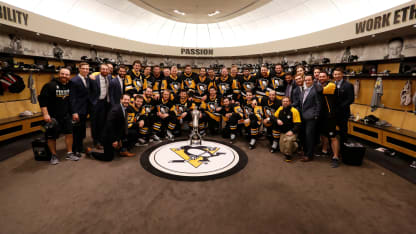
© Greg Shamus
Rust, who jokingly said people were thanking him at the grocery store after his heroics, will go down in folklore as a Game 7 hero for the Penguins, alongside names like Max Talbot and Darius Kasparaitis. Even with a lineup featuring Crosby, Malkin, Kessel and Letang, it was the kid from Michigan that would score two goals, the only two goals for Pittsburgh, in the biggest game of the season.
"If you write it up when you're a kid, this is how it goes," Rust said. "I was just hoping to make some kind of impact. I guess this is how it happened. … It's something I'll never forget or take for granted."
Sullivan gathered his team in the locker room. He was going to let them enjoy their accomplishment for the night. But he left them with an important message.
"I told them that we're not finished yet," he said. "We have to re-energize and get ready for this next round, which is the most important round of all."








